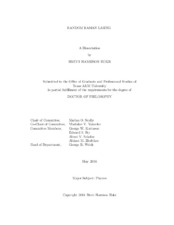| dc.description.abstract | The propagation of light in turbid media is something that is experienced by everyone, everywhere, everyday. These dynamics play an essential role in everything from the color of a material, to the multitude of colors present during a sunset. Considering the central role of these dynamics, there are still a great deal of outstanding questions that remain to be answered. Nonlinear light propagation in turbid media is one such question, with far ranging applications in biomedical imaging where it has potential to elucidate many biological processes label-free and in vivo. Conventional wisdom suggests that nonlinear effects, such as stimulated Raman scattering (SRS), should not play a significant role in the propagation of light through random media. The diffusive nature of elastic scattering restricts the interaction distance by limiting the depth at which high intensities can be delivered, thus reducing the efficiency of nonlinear optical effects. However, light scattering can dramatically increase the interaction length by multiply scattering the photons in a random walk type motion, making the overall outcome somewhat hard to predict.
Random Raman lasing uses SRS as the primary gain mechanism for a lasing process that receives feedback through multiple elastic scattering in the material. This is a fundamentally new optical system that pushes the boundaries of the understanding of light propagation in turbid media. The discovery of this lasing system will be presented along with several fundamental measurements of the process, some of which contrast with classical light transport theory and point towards exciting new physics. Furthermore, random Raman lasing opens the door to many exciting applications ranging from remote chemical identification at unprecedented range, in a single laser pulse, to a revolutionary new light source for imaging microscopy 10,000 times brighter than conventional sources while maintaining the low spatial coherence required for speckle-free imaging. | en |


